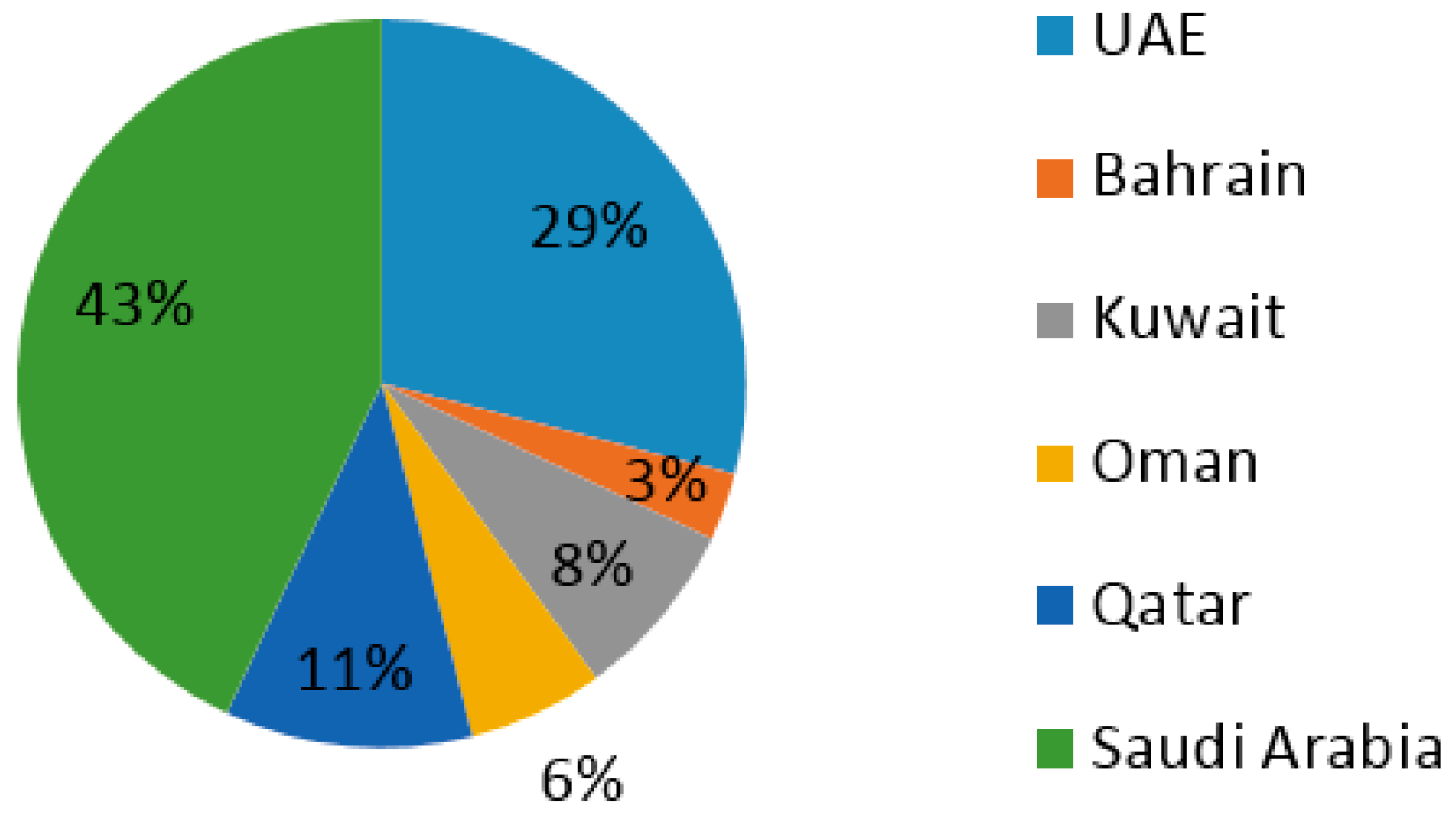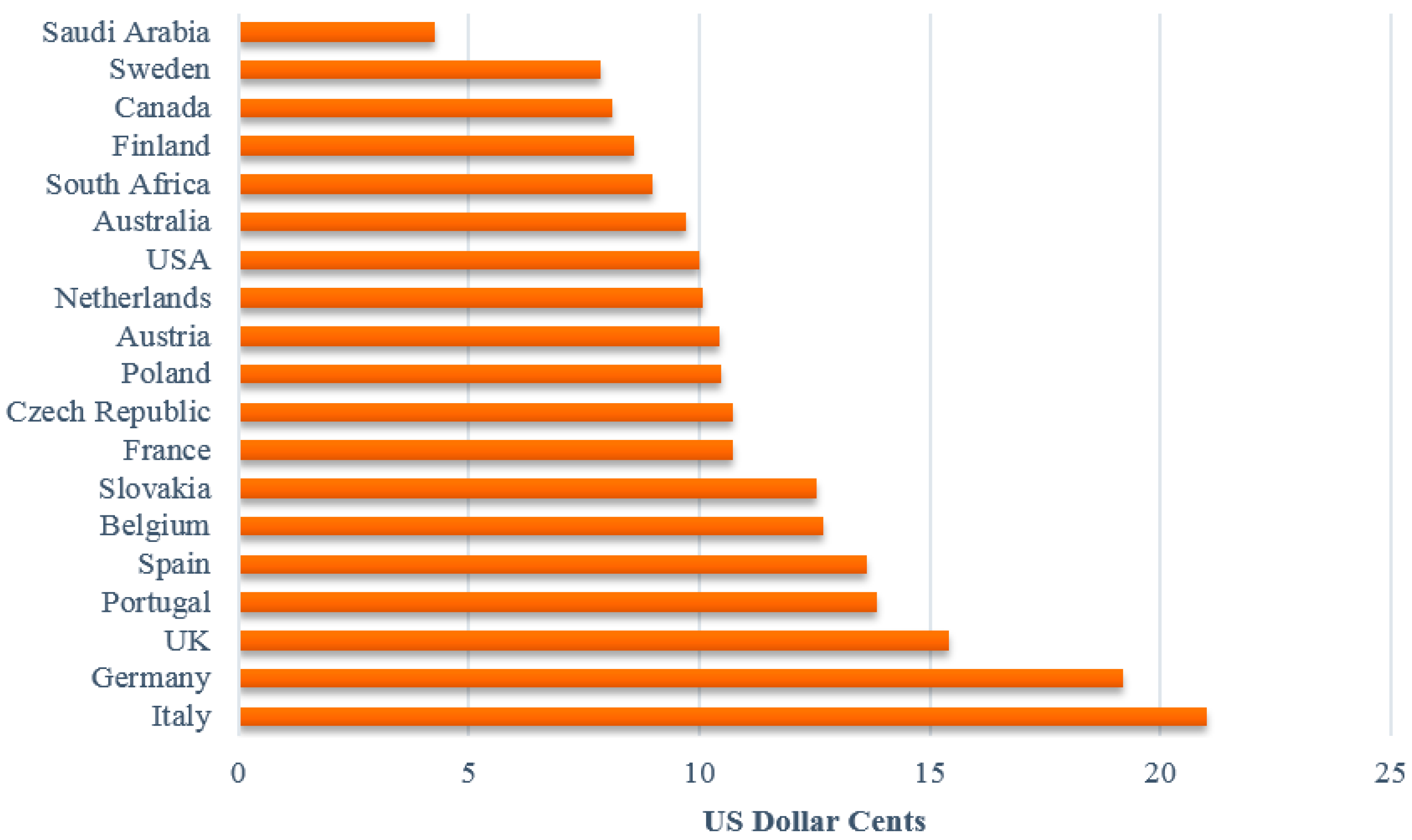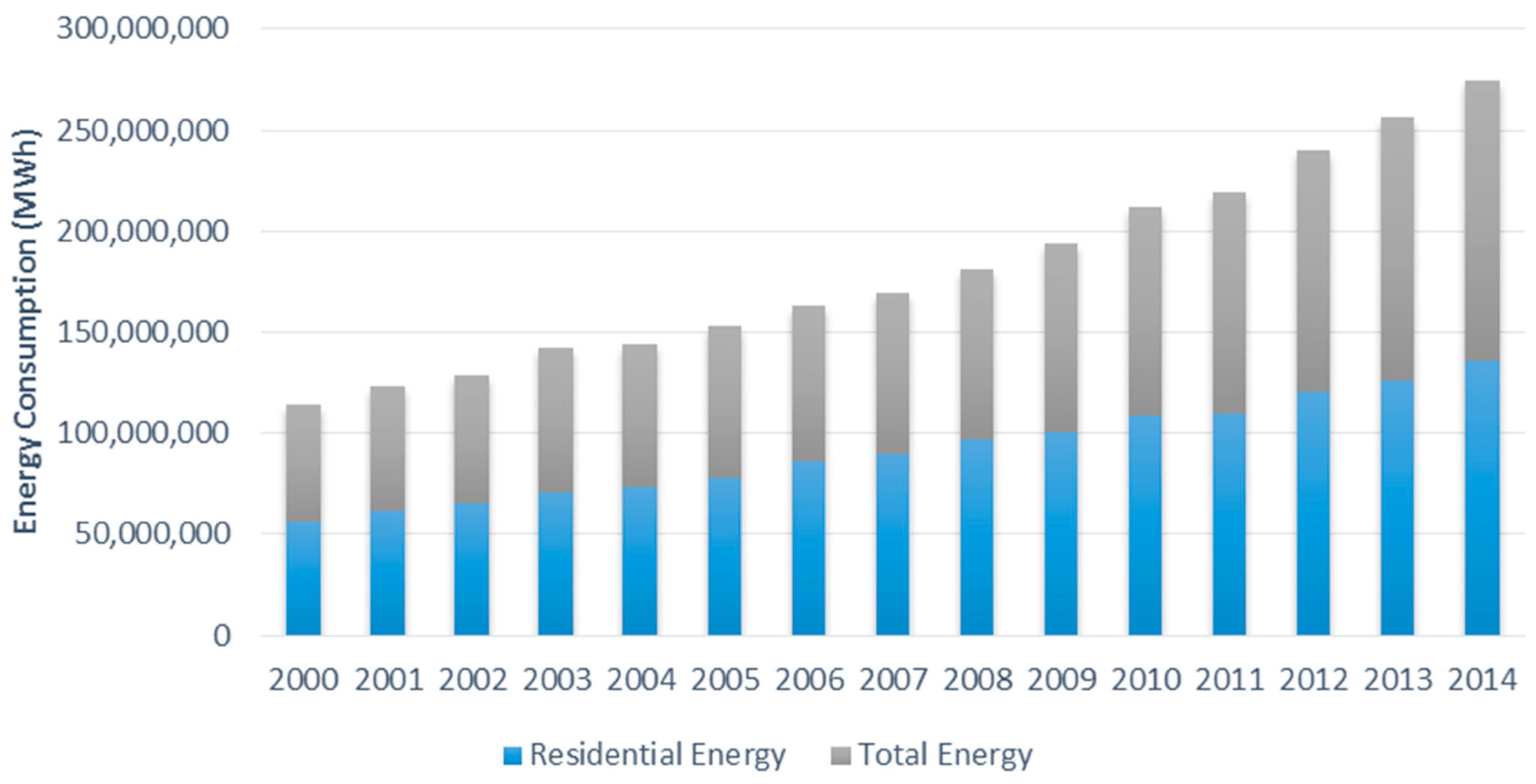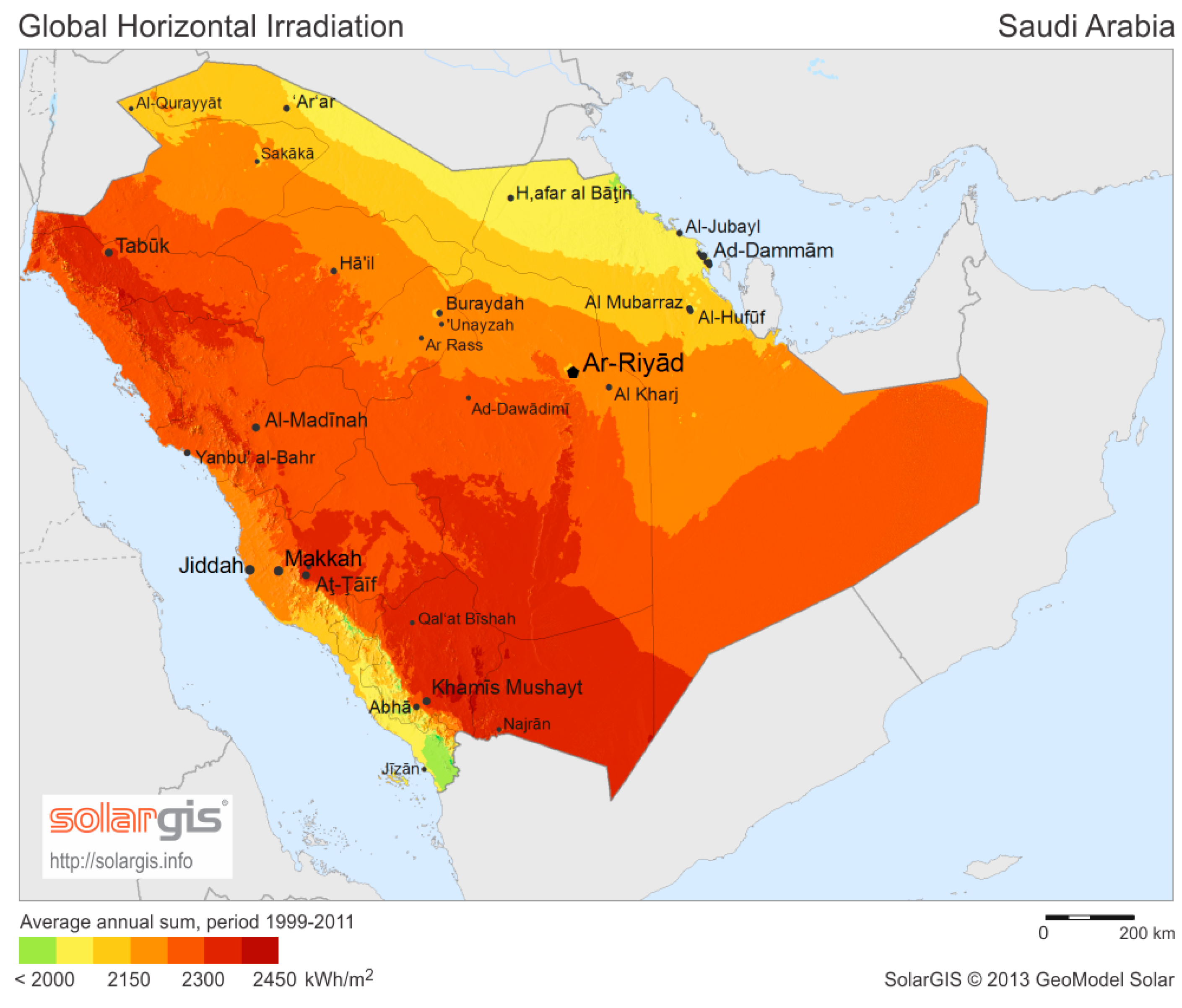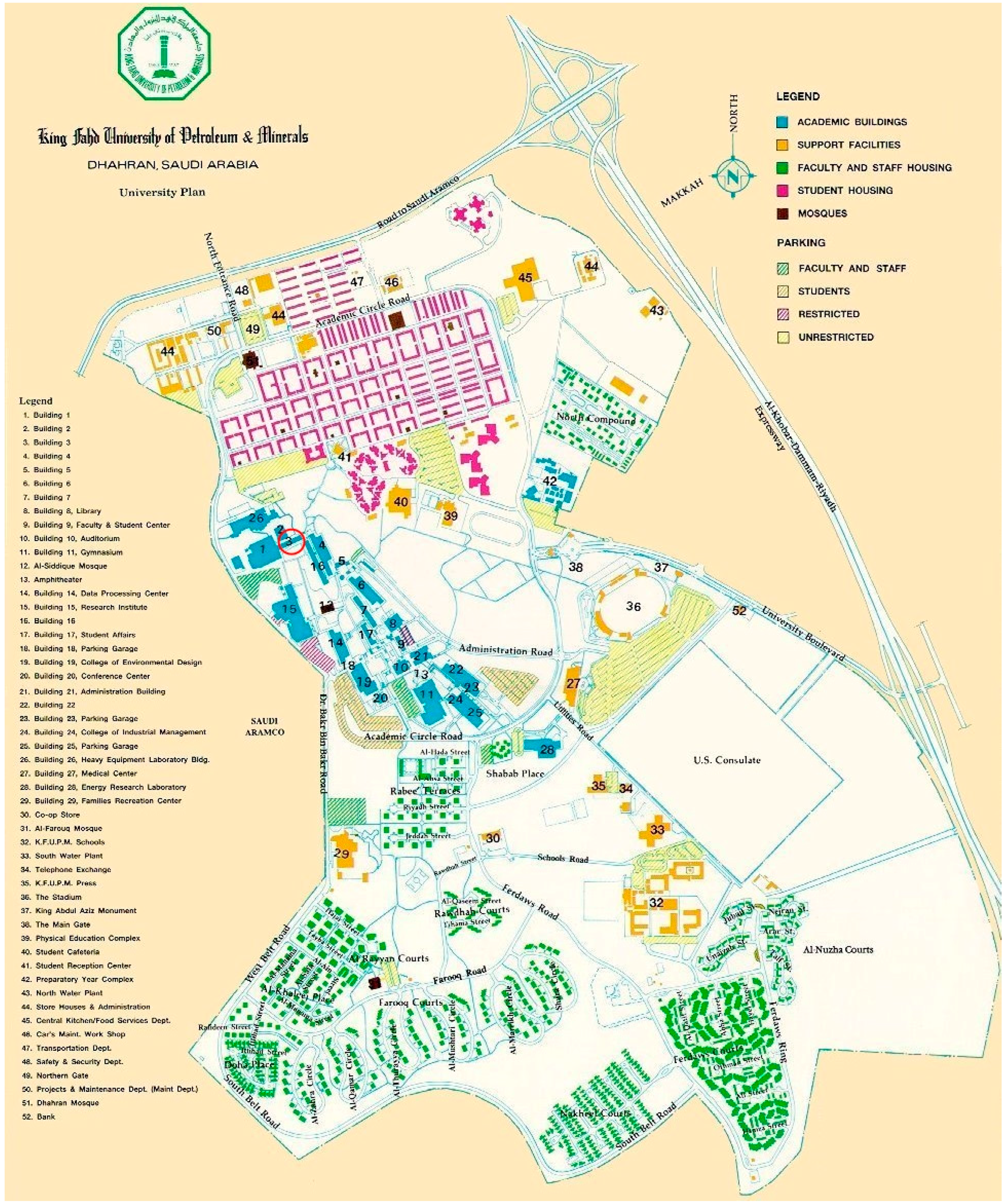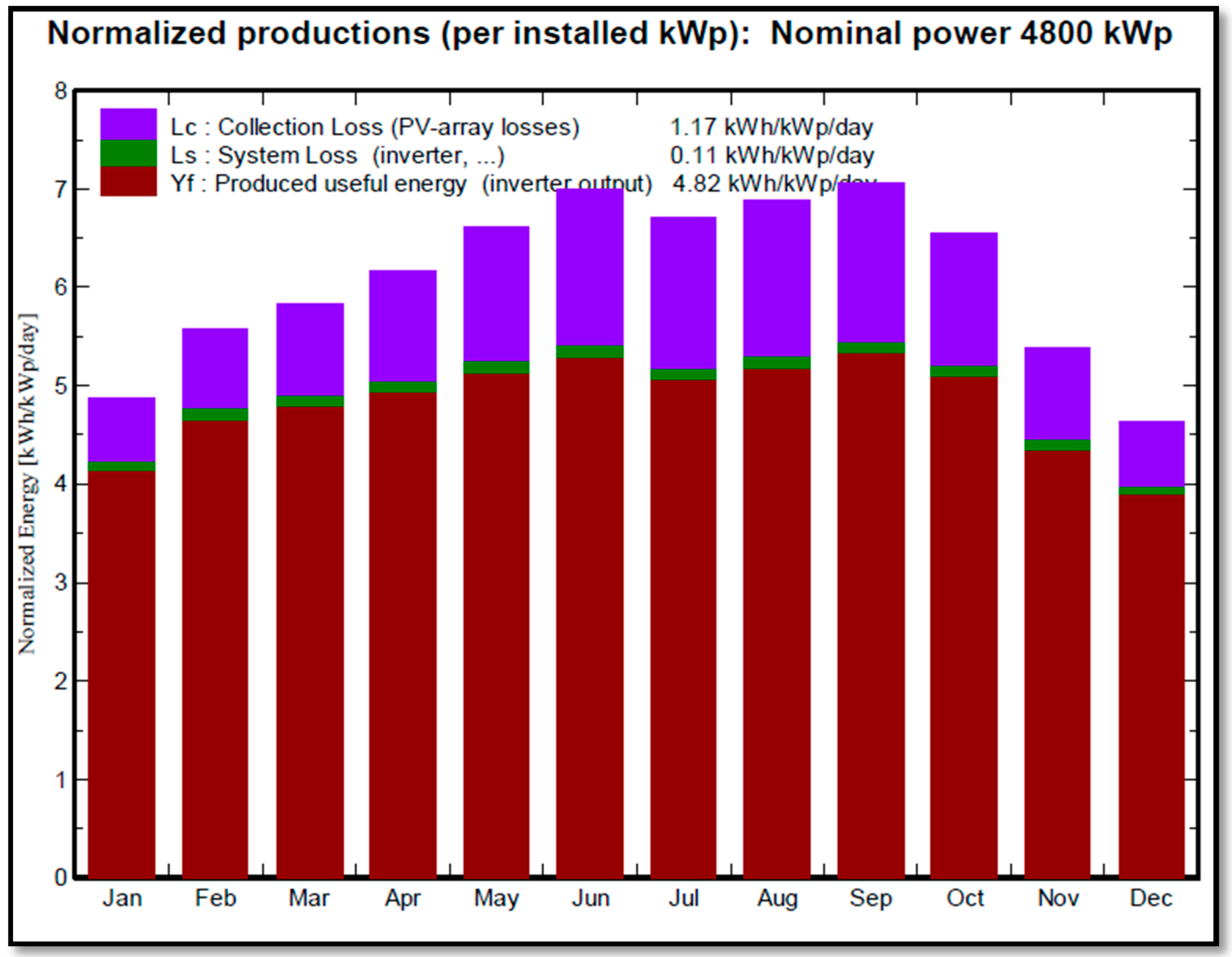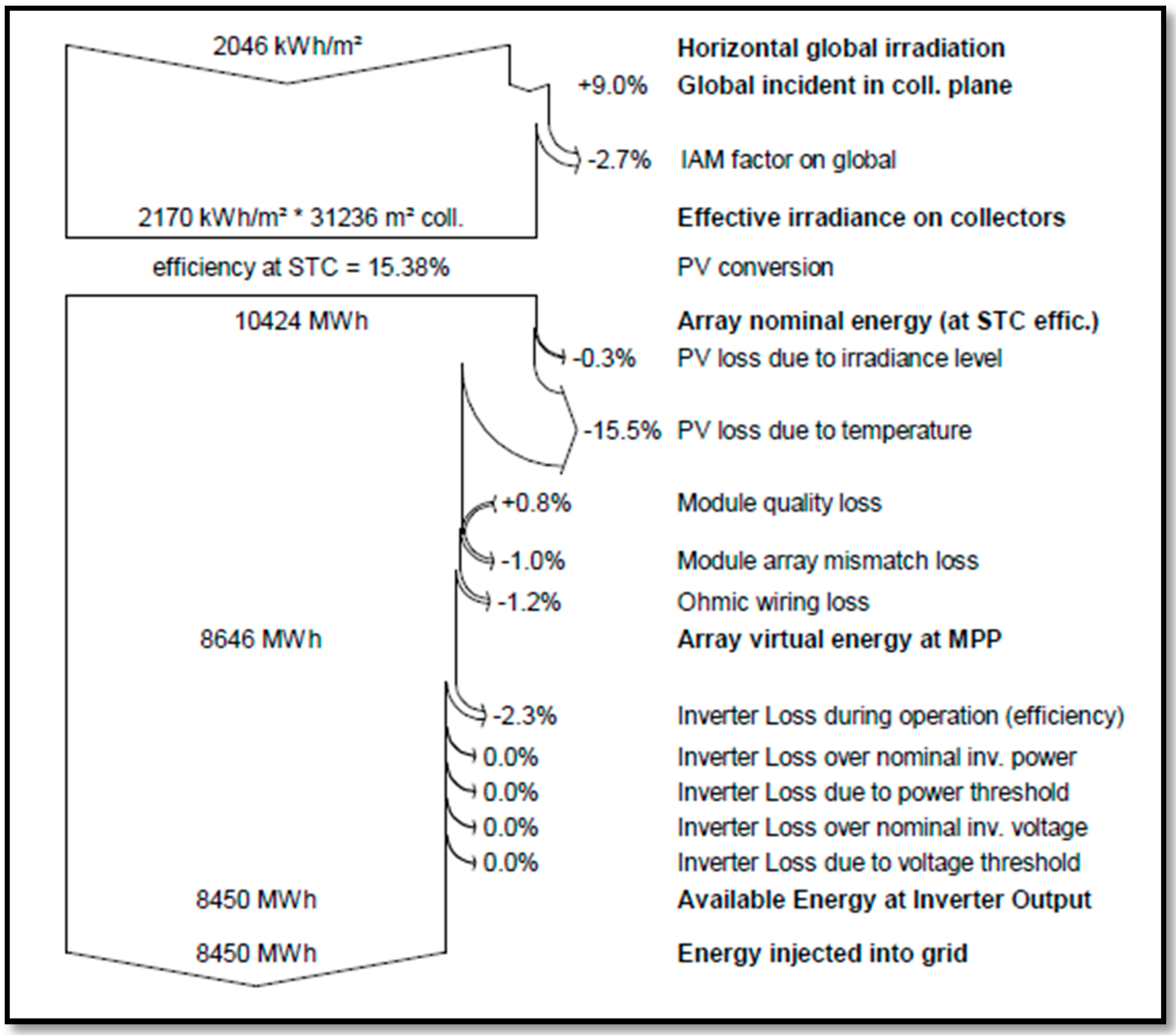1. Introduction
The role of renewable energy in meeting global energy needs is becoming ever more important. Due to its advantages, like a widely and abundantly available resource base, environmental friendliness and declining price trends, over the last couple of decades, renewable energy has experienced a rapid growth across the world. Statistics suggest that renewable technologies have now surpassed fossil fuel-based technologies in terms of annual capacity addition at the global level. Renewable technologies, contributing to over 23% of the global power generation, attracted a record 286 billion US$ of new investment in the year 2015. Solar photovoltaics (PV) are one of the most prominent renewable technologies. In 2015 it experienced an annual growth rate of over 28% with the net global installed capacity reaching at 227 GW [
1,
2]. Over 22 countries in the world are meeting more than 1% of their power requirements from PV. Italy, Greece and Germany are the leading countries in the world in terms of percentage of their power generation coming from PV with respective shares of 7.8%, 6.5% and 6.4%.
Small-scale and building-integrated applications have provided a substantial proportion of the global PV capacity. Germany, for example, the world’s leading country in solar PV installed capacity, benefits mainly from small-scale systems. Having pioneered the feed-in tariff (FIT) concept in the early 1990s, it has managed to establish a large base of small-scale PV power producers, mainly from the residential sector. Germany’s successful FIT policy has been replicated elsewhere in the world and countries like Italy, Japan, Spain, UK and USA have also seen their PV market rapidly flourish. Since 2010, UK, for example, has seen its PV capacity grow exponentially due to conducive policies like FIT and renewable obligation certificates (ROC). Statistics reveal that the installed capacity of PV in UK has jumped from less than 50 MW at the start of 2010 to over 10,000 MW by the beginning of 2016 [
3]. Over the five-year period between 2010 and 2015, the FIT has supported development of over 3700 MW of renewables of which around 87% has been through solar PV. Over 70% of the PV projects supported under the FIT scheme are small scale (under 10 kW) [
4]. FIT is now being practiced in over 50 countries across the world [
5]. In developing countries, other types of business models such as micro-credit-based systems have enabled PV to gain significant ground in the national power supply base.
Saudi Arabia is the largest country in the Arabian Peninsula in terms of population, geographic outreach and economy. It is also one of the richest countries in the world in terms of oil and gas reserves, leading to an energy-affluent lifestyle. Over the last few decades, in the pursuit of development and modernization, the country has experienced a rapid growth in the building and construction sector [
6,
7]. Owing to factors like rising population, modernization and economic development, between 2009 and 2025, the electricity demand in the residential sector is expected to more than double. While around two-third of the population is under the age of 30 years, estimates suggest that in order to meet the needs of the growing population, the country has to build 2.32 million new homes by 2020 [
8,
9,
10]. Already one of the highest countries in the world in terms of per capita energy consumption and carbon dioxide emissions, the situation there is going to significantly add to the energy and environmental burdens it faces [
6]. For sustainable development, the situation requires a major shift in the energy consumption patterns in the building sector. Besides energy conservation strategies, use of renewable technologies can significantly help improve the energy and environmental footprint of buildings. Traditionally Saudi Arabia has relied on fossil fuels to meet its energy requirements. Despite having taken initiatives more than three decades ago, the country is yet to see renewable energy making any considerable inroads in its energy and building sectors. Key barriers in this respect include huge public subsidies for fossil fuels, government preferences to large scale and centralized projects, investment risks, lack of administrative experience with renewable technologies, and regulatory issues.
Saudi Arabia is now keen to diversify its energy base by exploiting its renewable resources. Strong solar radiation levels amounting to an average yearly value of over 2200 kWh/m
2 are one of the key strengths of the country’s renewable base [
6]. The country has given itself a target of setting up 9.5 GW renewables by 2030, most of which is projected to come from solar energy [
11]. The focus of the country thus far has been on large or industrial scale projects overlooking the application of PV in buildings. This is an area that needs attention. Besides developing large scale PV projects, KSA also needs to exploit its small-scale generation potential especially through the building sector.
This study aims to examine the prospects of urban scale application of PV systems in the King Fahd University of Petroleum and Minerals (KFUPM). Given its large and diverse building infrastructure, population and energy demand, KFUPM is regarded to be a suitable case study area at urban scale level. The whole building infrastructure of the university campus has been examined for utilizable roof top area for PV application. Energy yield from the designed rooftop PV systems has been modeled with the help of PVsyst software. The study also provides emission analysis with the help of RetScreen software besides discussing policy guidelines to promote PV systems in the Saudi building sector.
2. The Energy Outlook of KSA and Solar Energy Initiatives
Saudi Arabia is among the leading countries in the world in terms of per capita energy consumption. The building sector is one of the main contributors of energy and environmental challenges facing the country. It has a fast-growing building sector with over 43% of all new construction projects within the GCC region, as shown in
Figure 1 [
6]. This situation translates into rapid growth in demand for energy from this sector adding to the stresses on the national energy and environmental scenarios. Buildings account for nearly 80% of the national electricity consumption, a figure well above the global average. Residential buildings alone consume over 51% of the total electricity [
12,
13,
14,
15,
16]. Heavily subsidized energy prices have been an important factor in energy-expensive life style. A comparison of electricity tariffs in KSA with a number of other countries is provided in
Figure 2 [
17]. The electricity prices in KSA are on the higher end when compared with other GCC countries as well. Over the last couple of decades KSA has experienced a steep rise in energy demand as shown in
Figure 3 [
18]. The annual growth rates in electricity consumption and the number of consumers over the last decade have been reported to be as much as 8% and 5% respectively [
19]. Forecasts suggest that by 2040, the electricity consumption in KSA will increase from the current figure of 277 TWh/Year to as much as 850 TWh/Year. The situation is projected to require the installed power generation capacity to reach up to 185,000 MW, requiring an annual addition of 4200 MW. In the oil and gas perspective which are the main sources for power generation in Saudi Arabia, the final consumption is forecasted to increase from 105 Mtoe (Million Ton of Oil Equivalent) in 2009 to about 425 Mtoe with total production of Saudi Arabia estimated at 534 Mtoe [
20]. Such a massive surge in demand is bound to have enormous impact not only on the energy and environmental but also the economic outlook of the country as export of oil and gas has traditionally been the backbone of its national revenues. The situation demands a paradigm shift in energy generation and consumption patterns.
Renewable energy is widely deemed to be an appropriate solution to address energy and environmental challenges across the world. It offers inexhaustible, widely distributed and environmentally friendly energy generation opportunities through solar energy, wind power, bioenergy, hydropower, wave and tidal power and geothermal energy. Solar PV is one of the fastest growing renewable energy technologies. Application of solar PV has been a great success in many countries including Germany, Italy, Spain, Japan and USA. Interestingly, the main contribution in all these countries comes from the application of PV in buildings.
Saudi Arabia has targeted the development of 9.5 GW of renewable energy by 2030 in its latest national roadmap, Vision 2030 [
21]. The vast majority of this target has to be met through solar technologies like PV and solar thermal power. However given the huge growth requirements in annual installed capacity, traditionally the focus has been on large scale power generation projects. The same applies to plans for solar power, so there has not been any emphasis on small-scale or building-integrated PV systems as yet. Saudi Arabia developed its first solar PV project, Saudi Solar Village, with 350 kW capacity, in 1981 to supply power to almost 3000 inhabitants in a remote village. The project encountered several technical issues predominantly due to harsh weather conditions [
22]. It was followed up with another experimental project of the same capacity to produce hydrogen in 1993. These two experimental projects did not see any considerable follow up initiatives until a 2 MW solar PV project was developed in 2010 in the King Abdullah University of Science and Technology as indicated in
Table 1. In recent years there have been a few other large-scale projects such as the 10 MW solar car parking project developed by Saudi ARAMCO in 2011. Over this whole period, there have not been any notable projects of application of PV in buildings. Other significant developments at the regional level include the 10 MW Masdar City Solar PV Plant developed in 2009. While the Zero Carbon City project of the Masdar City, involving development of sustainable homes also utilizing PV systems, is scheduled to be completed in 2016, it is facing delays [
23,
24].
Given the ambitious renewable energy targets the country has set for itself, application of PV in buildings is an important avenue that needs attention in the form of strong policy framework and active follow up plans. Application of PV has been revolutionized across the world through some very successful policies such as feed-in-tariff (FIT) and net-metering. Germany, having pioneered the FIT, has become the global leader in solar PV, thanks to PV application in buildings. The FIT and net-metering policies have been adopted by over 50 countries in the world. It is time for Saudi Arabia to develop proactive policies on similar grounds to motivate the building sector to use PV systems. Besides supporting the consumer, utility also needs to be on board and policies like renewable obligation certificate (ROC) can be greatly helpful in this respect.
3. The Case Study Area
The King Fahd University of Petroleum and Minerals (KFUPM) is one of the largest university campuses in Saudi Arabia located in the city of Dhahran in the Eastern Province of KSA. Dhahran is located in the Eastern Province of Saudi Arabia. It is situated at 26°18′29″ North, and 50°9′1″ East, with a mean elevation of 62 m above sea level. Dhahran has a relatively modest solar radiation level at the national scale, still reaching to an annual figure of around 2100 kWh/m
2 as indicated in
Figure 4. Further detailed overview of the solar energy potential of Dhahran is highlighted in
Table 2.
Like the rest of the country, KFUPM is also experiencing a rapid growth in infrastructure for similar trends i.e., rise in number of students and staff, development of new buildings, labs and other infrastructure and modernization. The KFUPM campus is selected as the study area of the research as in terms of population, infrastructure and utilities requirements it resembles a small city and fits well with the scope of the work. For example, it has wide range of building types including various types of residences, shopping centers, community centers, sport centers, academic and administration blocks, student housing, schools, restaurants, medical center, workshops, warehouses and multipurpose buildings, as can been in
Figure 5. The solar radiation levels at the site are provided in
Table 2.
4. PV Design Calculations
Estimation of the availability of area for PV installation is one of the fundamental design requirements. The present study focuses on the rooftop area for PV installation. In terms of roof construction, KFUPM is exclusively composed of buildings with flat rooftops. The total roof area available on various types of buildings in the campus has been calculated with the help of ArcGIS 10.2 as shown in
Table 3.
PV cannot cover all of the roof areas mainly due to spacing required for shadow adjustment and any structural features, i.e., HVAC systems, skylights and staircases. The utilizable area therefore needs to be calculated taking into account these obstacles. The impact of shadow is influenced by the tilt angle of PV panels. Space between successive rows of PV panels has to be allocated to avoid the effect of shadow on panels and also to undertake cleaning and maintenance work. The car parking buildings also have their roofs used as parking space, leaving no room for PV systems. Given the unavailability of the car parking roof areas for PV application, they are not being included in the effectively available area and are hence excluded in calculations from here onwards.
Table 4 provides percentages of roof area that can be used for PV for a sample building from each type.
Different types of buildings make varying degree of its roof area available for solar PV depending upon their architectural and construction features and utilization. The difference between the proportions of utilizable roof area of these buildings for PV use seems to be in close proximity, 38% to 44%. The total available area in different categories of campus buildings has been estimated in
Table 5.
Table 5 shows how at the urban level, utilizability of rooftops for PV application can vary in terms of building typology. It is observed that for different types of buildings the net utilizable area for PV use varies between 25% and 41%. Overall, 34% of the total available rooftop area can be utilized for PV application. Typical residential buildings, faculty housing in this case, offer the least for PV application, mainly due to hurdles like satellite dish antenna, HVAC systems and stair cases. Industrial buildings, represented by workshops and warehouses in the study area, on the other hand, offer the greatest potential for having less crowded rooftops with these obstructive features.
5. PV Output Modelling
For the calculated utilizable roof area the energy production from the installed solar panels has been estimated with the help of PVsyst software employing the Dhahran weather conditions. Specimen energy yield calculations for the academic buildings are provided in
Figure 6 and
Table 6.
Figure 7 specifically provides a detailed flow diagram of PV energy production from academic buildings, while also highlighting the involved losses at various stages.
The total energy production from different types of buildings has been summarized in
Table 7. It can be seen that the annual total energy yield from the PV systems on all university buildings turns out to be 37,746 MWh. For the generated amount of energy, greenhouse gas emissions saved have also been calculated with the help of RetScreen software suggesting a total annual saving of 30,875 Metric tons CO
2e.
KFUPM is experiencing a growing trend in energy demand with figure for the year 2015 estimated as 235,591 MWh, as indicated in
Table 8.
The output from the PV systems on all KFUPM buildings, 37,746 MWh, turns out to be over 16% of the total KFUPM demand. This is a significant contribution that can be potentially made by rooftop PV systems in KFUPM. It will not only help reduce burden on national grid but also add to the sustainability of the campus by producing green and environmentally friendly energy.
6. Conclusions
The study investigates the prospects of the application of PV systems in buildings in Saudi Arabia by taking the King Fahd University of Petroleum and Minerals (KFUPM) as a case study. The total rooftop area available on all KFUPM buildings has been calculated to be 505,165 m2. Taking into account the necessary shadow avoidance spacing and obstructive features on building roofs such as HVAC systems, TV satellite dishes, stair cases and skylights, a net area of 171,310 m2 has been found to be utilizable for PV systems. For different types of buildings the utilizable area has been found to be in the range of 25%–41%, with residential buildings having the least potential. The modelling exercise undertaken with the help of PVsyst software reveals that the PV cells receiving an annual irradiance of 2170 kWh·m2 exhibit a performance ratio of 79%. The system loss analysis suggests that the single greatest penalty is due to temperature with a value of 15.5%. Results indicate that 37,746 MWh of electricity can be annually generated from the installed rooftop PV systems resulting in environmental emission savings of 30,875 metric tons of CO2e. It is noted that over 16% of the total energy requirements of the KFUPM campus can be met through these systems. Use of environmentally friendly technologies like PV can significantly help the building and energy sectors become more sustainable. It can also help the power sector shave down peak load demands. In recent years, countries across the world have experienced a rapid growth in PV installation driven by conducive policies such as feed-in tariffs, net-metering and renewable obligation certificates. Feed-in tariffs in particular have propelled the PV applications in buildings in over 50 countries, and Saudi Arabia also needs explore it as a way forward.
